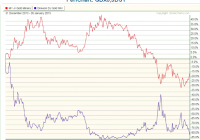Cyber Warfare Risk: What Are The Investment Impacts?
by Ron D’Vari The devastating cyber-attack against Sony and its allegedly state-sponsored origins raises several key questions with respect to the security risk for the global financial system. For example: Should investors be worried about advanced threats on the global financial system by cyber terrorists and/or state-sponsored adversaries to destabilize the global economy and markets? Could there be attacks on the Federal Reserve, the U.S. Treasury or one or more mega banks of a magnitude that would destabilize the U.S. dollar and prompt a global stock market collapse? Do U.S. monetary and fiscal policies render this type of cyber threat potentially more devastating? In what ways could the cyber-threat to the financial system affect the relative attractiveness of “real assets” (real estate, physical commodities, infrastructure investments, etc.) vs. “financial assets” (enterprise value-related assets)? U.S. intelligence agencies as well as major companies are gradually waking up to the critical nature of cyber security to systemic financial stability. Indeed, the financial services industry has already recognized it can no longer work in isolation, marked by the formation of a member-owned non-profit entity, the Financial Services Information Sharing & Analysis Center (FS-ISAC), to provide resources for cyber and physical threat intelligence analysis and to share information about hackings. The U.S. government has not yet developed a unified approach to help companies coordinate a response to an attack and share information. Complications and lack of coordination in the Sony case made that obvious. As a result, the government is expected to sharpen its focus on this. Companies and government agencies will be investing large sums of money in innovative encryption and firewall solutions to make data, Internet and payment systems safer. Cyber war games have already been created as a way to test a company’s response to cyber incidents. The net effect will be positive for investments in the cyber security industry, but may also lower the overall profitability and productivity of the economy in aggregate. Financial advisers have already been warming to real assets as stock market volatility has picked up and demand for a long stream of cash flows by pension funds has increased. With increasing incidents of cyber-attacks, the trend is expected to continue. There will naturally be a slew of litigations in high-profile data breaches and operation interruptions. These will include claims by employees, customers, suppliers and shareholders. Shareholders can sue if a breach affects share values and future financial streams. Now that you’ve read this, are you Bullish or Bearish on ? Bullish Bearish Sentiment on ( ) Thanks for sharing your thoughts. Why are you ? Submit & View Results Skip to results » Share this article with a colleague
